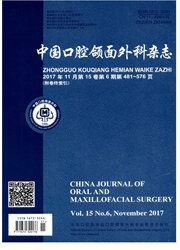

 中文摘要:
中文摘要:
目的:通过分析对矿化结晶胶原-羟基磷灰石骨修复材料的理化性能,对其力学和结构学性能的缺陷提出解释。方法:以矿化结晶法构建羟基磷灰石(HA)位于胶原(Col)纤维表面的矿化结晶Col—HA骨修复材料,通过扫描电镜(SEM)分析其结构特性,差示扫描量热仪(DSC)和拉伸试验分析其力学及热力学性能,X射线光电子能谱仪(ESCA)和X射线衍射仪(XRD)比较骨修复材料的元素组成及组合态。结果:形态学上,矿化结晶Col—HA骨修复材料结构松散,不能切割;结构上,羟基磷灰石位于胶原纤维表面,聚集成结晶球,形态不规则,结晶结构为弱结晶结构;ESCA显示,HA结晶位于胶原纤维的极性集团表面;断裂强度由Col支架的0.78MPa降低到0.21MPa.弹性范围由3.86%降低到1.13%;热变性温度由109℃降低为102℃;最终,导致支架的亲水性降低,整体降解性能降低。结论:矿化结晶过程破坏了胶原纤维的超微观结构,进而导致矿化结晶胶原一羟基磷灰石骨修复材料在力学性能方面的缺陷。
 英文摘要:
英文摘要:
PURPOSE: To construct bionic collagen-hydroxyapaptite bone substitute materials through mineralized crystallization, and then assess its structure, physical and chemical performance for explaining its shortcoming in mechanical property. METHODS: Collagenhydroxyapatite scaffolds with HA on the fibre surface of Col were prepared using a phase-separation technique and mineralized crystallization. The structure characteristics were investigated by SEM, the mechanics properties were analyzed by DSC and tensile test, and the surface elements were determined through ESCA and XRD. RESULTS: In this material, the hydroxyapatite crystallized around the polar groups on collagen fiber surface, the material was loosely organized, and the shape was irregular. The mechanical strength of matrices was decreased by the process of mineralized crystallization. Compared with Col matrix (0.78 MPa), the tension strength of MC bone matrix decreased significantly (0.21 MPa). The rupture length also decreased from 3.86% to 1.13%. And the transition temperature in DSC reduced from 109 ℃ to 102 ℃. CONCLUSIONS: It is indicated that this bone substitute material has inferior mechanical properties. The mineralized crystallization process destroys the ultra-microstrueture of the collagen fiber, and causes the shortcoming of material's mechanics performance. Supported by National Natural Science Foundation (Grant No.30700848 and 30772443) and Natural Science Foundation of Beijing Municipality (Grant No. 7042058).
 同期刊论文项目
同期刊论文项目
 同项目期刊论文
同项目期刊论文
 Effect of chondroitin sulfate modification on rhBMP-2 release kinetics from collagen delivery system
Effect of chondroitin sulfate modification on rhBMP-2 release kinetics from collagen delivery system Comparisons of collagen gel and collagen matrix as cell growth microenvironment: the physical-chemic
Comparisons of collagen gel and collagen matrix as cell growth microenvironment: the physical-chemic 期刊信息
期刊信息
